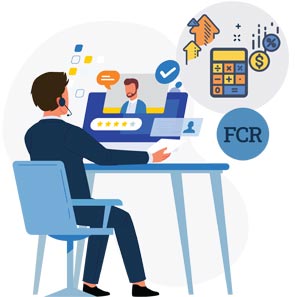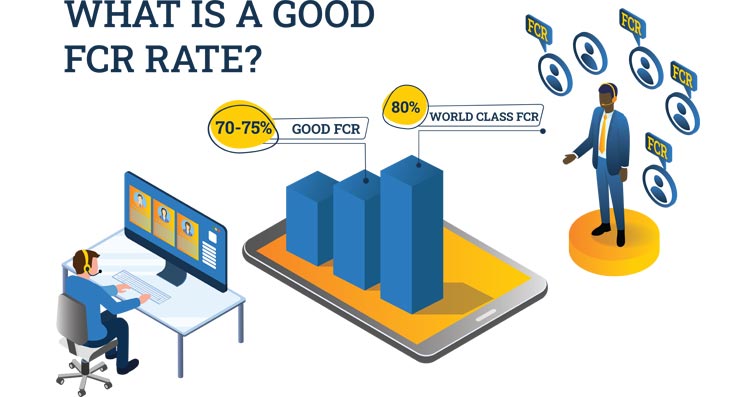First Call Resolution Rate Calculation
SQM's research shows that 93% of customers using the call center expect to resolve their inquiry or problem on the first call. First Call Resolution (FCR) is a metric that measures a call center's ability to resolve a customer's inquiry or problem on the first call.
FCR is the KING of all call center metrics because it measures your customer experience (CX) performance, is a key indicator of your operating cost efficiency, and provides you with insights into areas to improve CX and service recovery opportunities. FCR metric should be viewed as a balanced scorecard metric because it measures service and cost and is the leading indicator for Csat, customer referrals, and retention.

Most call center managers struggle with defining and calculating FCR. The most common reason for this struggle is that they do not have a working definition or do not know how to calculate FCR and call resolution correctly. The way call center First Call Resolution (FCR) is defined plays an essential role in calculating the FCR rate. Below is how SQM defines FCR and is applicable for measuring and calculating external and internal FCR.
It's up to an organization as to how they want to measure and calculate their call center FCR rate. The key is to come up with your data-gathering criteria by answering a few questions:
- Who determines if FCR was achieved? (i.e., customer, organization, or both)
- What constitutes a repeat call?
- Which call types does FCR apply to?
- Which contact channels does FCR apply to?
- Do you use escalated or transferred calls for determining the FCR rate?
- Is an escalated or transferred call to another department considered non-FCR?
- If the initial call was not resolved and a customer used another contact channel (e.g., website, chat, email, IVR, etc.) to resolve their inquiry, is it considered FCR?
- When is an inquiry considered FCR? (No repeat call with 24 hrs, 1 week, 30 days, etc.)
- Are abandoned calls due to wait times before an agent interaction considered non-FCR?
- If a customer hangs-up the phone due to long hold times, is that considered non-FCR?
- What does it mean to resolve a customer's inquiry or problem sufficiently?
- Is an outbound call-back considered non-FCR?
- Once you have chosen the data-gathering criteria, how will you calculate FCR?
For internal FCR measurement methods (e.g., QA, CRM, telephony technology-ACD/IVR, etc.), the organization determines if FCR was achieved based on the criteria chosen. Conversely, with external FCR measurement methods (e.g., post-call survey), the customer decides if FCR was achieved based on the criteria chosen. In many cases, when internal FCR measurement methods are used, FCR tends to be 10-20% higher than when an organization uses external FCR measurement methods. One of the main reasons why internal FCR measurement is substantially higher than external FCR measurement is the criteria that an organization uses to define and calculate FCR. Put differently; many call centers use criteria or calculation methods that inflate the FCR rate.
When using external or internal FCR measurement methods, the best practice is to make all calls eligible, or as much as possible, for determining the call center's FCR rate. The benefit of using all customer calls, or most calls, is that it is a more accurate approach for determining the call center FCR rate. A best practice is for FCR to be determined from the customer's perspective. When the FCR rate is inflated, the service improvement and cost reduction opportunities are under-reported.
What is a Good First Call Resolution Rate?
At SQM, we benchmark the FCR rate with over 500 leading North American call centers annually and have been conducting FCR benchmarking studies for 25 years. Our Voice of the Customer (VoC) FCR benchmarking research is one of the most extensive research studies of FCR performance.
For our VoC FCR benchmarking studies, all call center participants must provide SQM a list of all calls they handled to ensure the customer surveying is a random sample of all calls their call centered handled. Making all calls eligible for a customer survey ensures that the FCR rate is accurate. This approach also allows us to benchmark the call center's FCR rate against their specific industry, the call center industry as a whole, and world class call centers.

SQM's research shows that when an organization uses external VoC FCR measurement methods (e.g., post-call survey, etc.), the call center industry average for FCR rate is 70%. This means that 30% of customers have to call back the organization about the same inquiry or problem. A good first call resolution rate is 70% to 75%.
Of the 500 leading North American call centers that SQM benchmarks, only 5% are at the world class VoC FCR performance level of 80% or higher. Achieving the world class standard of 80% or higher VoC FCR performance is the most popular FCR improvement goal that SQM clients strive to achieve and maintain.
Most call centers that consistently measure FCR using a post-call customer survey method improve their FCR rate. In fact, SQM's research shows that 70% of clients who consistently measure their FCR utilizing the post-call customer survey method improve year-over-year. The FCR gain by these call centers ranges from 1-20%. Call centers that implement VoC FCR measurement can expect an average FCR improvement of 3% or better, and in most cases, FCR improvement takes place within 90 days.
How to Calculate FCR
Once you have chosen the data-gathering criteria, you must decide how you will calculate the FCR rate. Below are the best practices for calculating external and internal FCR rates. The external post-call survey measurement method is used to calculate the FCR rate. At SQM, we consider the VoC FCR measurement and calculating method to be the most accurate method for measuring FCR. VoC FCR measurement lets the customer quickly judge whether FCR took place; after all, their opinion is what matters the most. Internal FCR measurement has limitations, such as if a customer called back with a different call reason not tied to their initial call reason or called back using a different phone number. These scenarios will make the FCR rate calculation less accurate. However, internal FCR measurement can be very insightful for FCR trending and is widely used by call centers.
External First Call Resolution Rate Calculation
For the external post-call survey measurement method calculation, the FCR rate is based on three survey questions. A call is considered FCR if a customer answers 'yes' to the question, "Was your call resolved?", in 'one call' to the question, "How many calls did you make to resolve your call?", and 'no' to the question, "Did you use another contact channel after you used the call center?"
FCR calculation based on post-survey results example: The total number of customers who said their call was resolved on the first call. No-repeat calls or other contact channels were required about the initial call reason (280) ÷ by the total number of customers who were surveyed (400) = 70% FCR performance level.
Internal First Call Resolution Rate Calculation
For the internal CRM and telephony technology (e.g., ACD, IVR) measurement methods, the FCR rate is based on whether the customer called back for the same issue within 1 to 30 days. It might be helpful to use different timelines based on call reason. For example, a claim call that requires the fulfillment department to conduct some investigation work might need 30 days to determine if FCR was achieved, but a status inquiry call might only need 5 days to determine if FCR was achieved.
FCR calculation based on telephony technology results example: The total number of calls resolved on the first call. No-repeat calls or other contact channels were required about the initial call reason (7,000) ÷ by the total number of unique customer transactions where no prior calls were made about the initial call reason (10,000) = 70% FCR performance level.
* Total # of customer/calls resolved on the first call refers to the total number of calls resolved with no-repeat calls or other contact channels required about the initial call reason.
** Total # of first calls refers to the total number of unique customer transactions where no prior calls were made about the initial call reason.
